目录
1. string类对象的常见构造
string的构造函数含有多种重载,常用如下:
// 1
string();//构造空的string类对象,即空字符串;
// 2
string(const char* s)// 用字符串 s 来构造string类;
// 3
string(size_t n, char c)//用n个字符c来构造string类;
// 4
string(const string& str)//用string类对象str,构造string类。即拷贝构造;代码实例:
// 1
string str1(); //构造一个空类
// 2
string str2("Hello World!!!!"); //用字符串Hello World!!!!构造一个类
// 3
string str3(5,'H');//用5个字符构造一个类
// 4
string str4(str2);//构造一个和str2一样的类2 string类对象的容量操作
1)size : 返回自字符串的有效长度;
函数原型: size_t size ( ) const

2)legth : 返回自字符串的有效长度;
函数原型: size_t length ( ) const

3) capacity : 返回空间总大小(不包含‘\0’);
函数原型: size_t capacity ( ) const

4) reserve : 为字符串提前开辟空间;
函数原型 : void reserve (size_t n = 0)
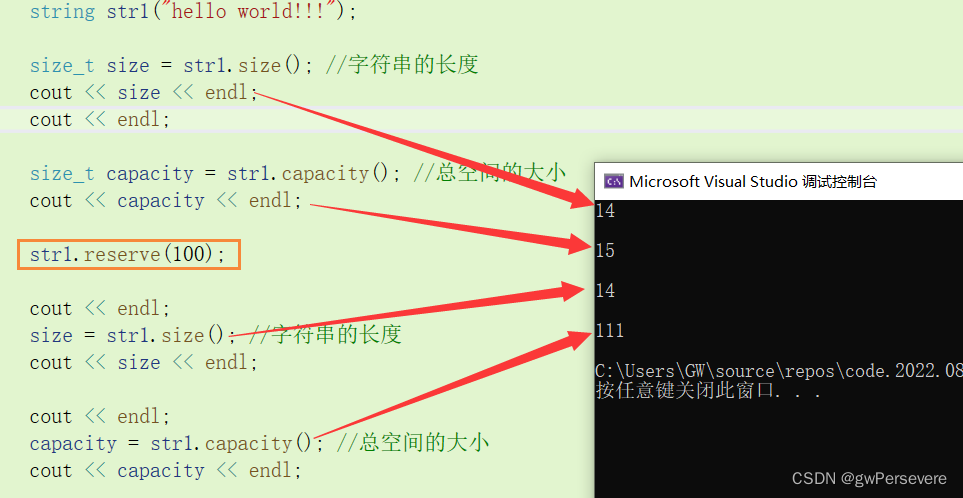
reserve()函数只开空间,也只改变容量。当知道需要多大空间时可以提前开好,以免扩容产生性能不必要的浪费。
代码:
#include<iostream>
#include<string>
using namespace std;
void text1()
{
string str1("hello world!!!");
size_t size = str1.size(); //字符串的长度
cout << size << endl;
cout << endl;
size_t capacity = str1.capacity(); //总空间的大小
cout << capacity << endl;
str1.reserve(100);
cout << endl;
size = str1.size(); //字符串的长度
cout << size << endl;
cout << endl;
capacity = str1.capacity(); //总空间的大小
cout << capacity << endl;
}
int main()
{
text1();
return 0;
}5) resize : 将有效字符的个数改成n个
函数原型: void resize ( size_t n)
void resize (size_t n, char c)
1)当 n 小于 capacity时,只改变 size 的大小,将size改为n,不改变capacity的大小;
执行resize( 5 )前:
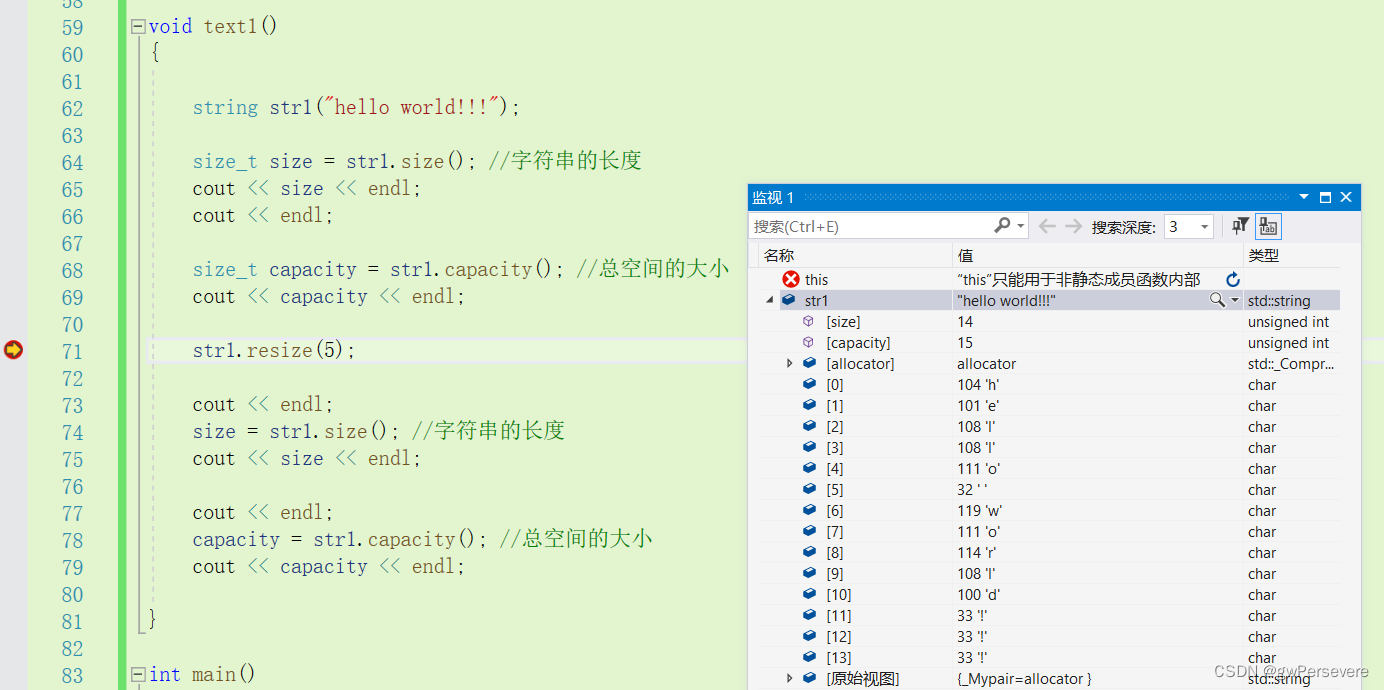
执行后:

结果:
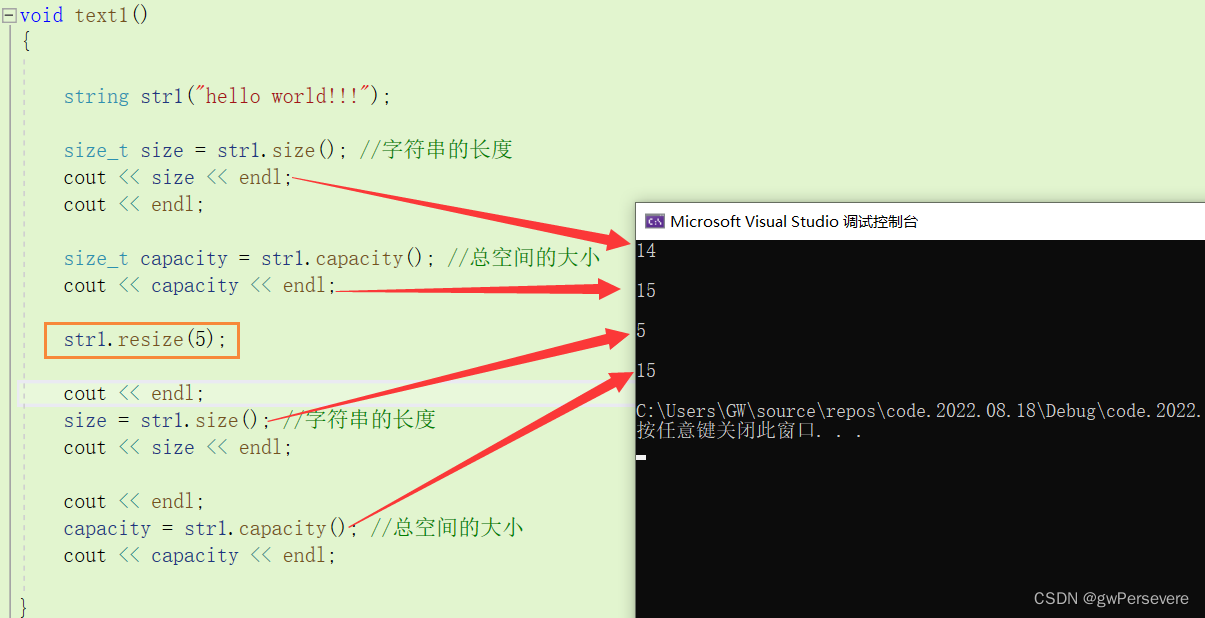
2)当 n 大于 capacity时,size、 capacity 的大小都会改变,并且会用 ‘\0’填充,若为函数2则用字符ch 填充;
执行resize( 50 )前:

执行后:

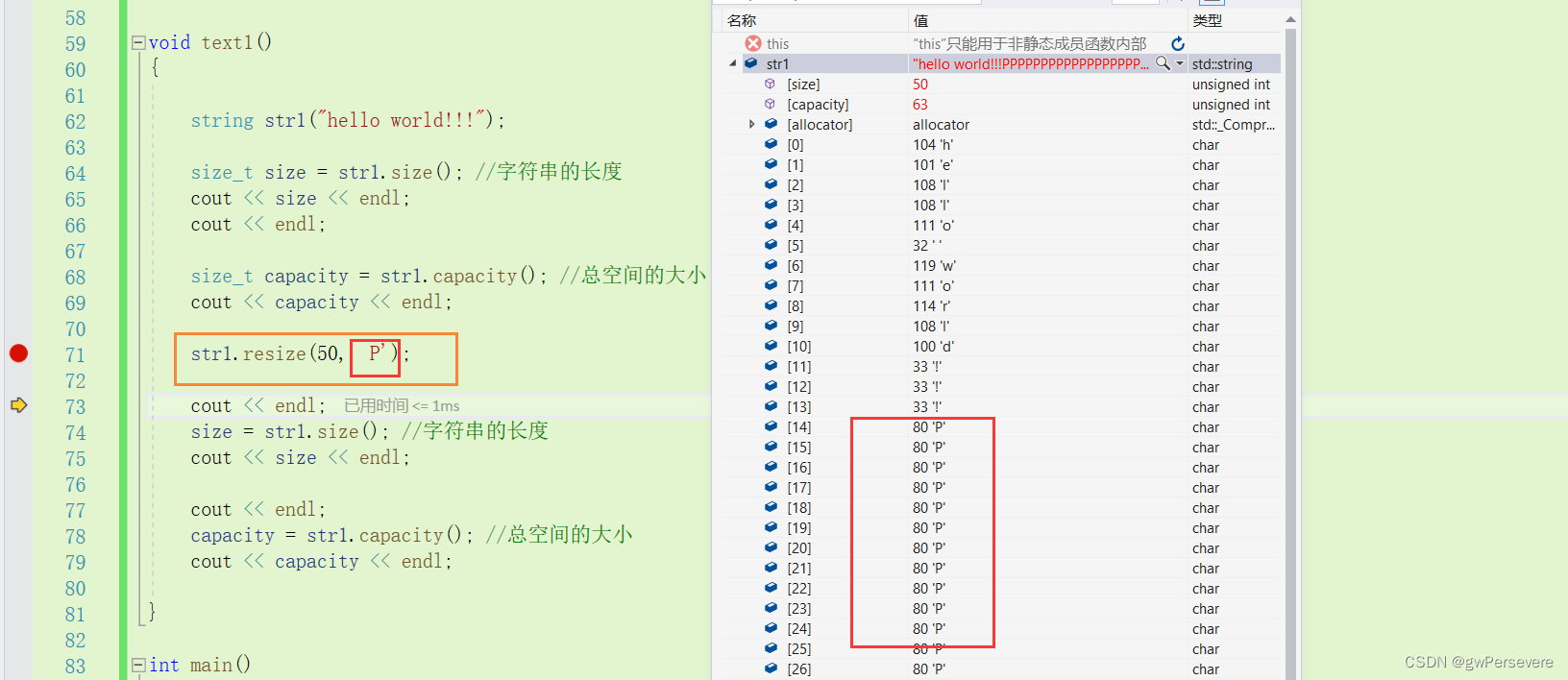
代码:
void text1()
{
string str1("hello world!!!");
size_t size = str1.size(); //字符串的长度
cout << size << endl;
cout << endl;
size_t capacity = str1.capacity(); //总空间的大小
cout << capacity << endl;
str1.resize(50);
cout << endl;
size = str1.size(); //字符串的长度
cout << size << endl;
cout << endl;
capacity = str1.capacity(); //总空间的大小
cout << capacity << endl;
}结果:
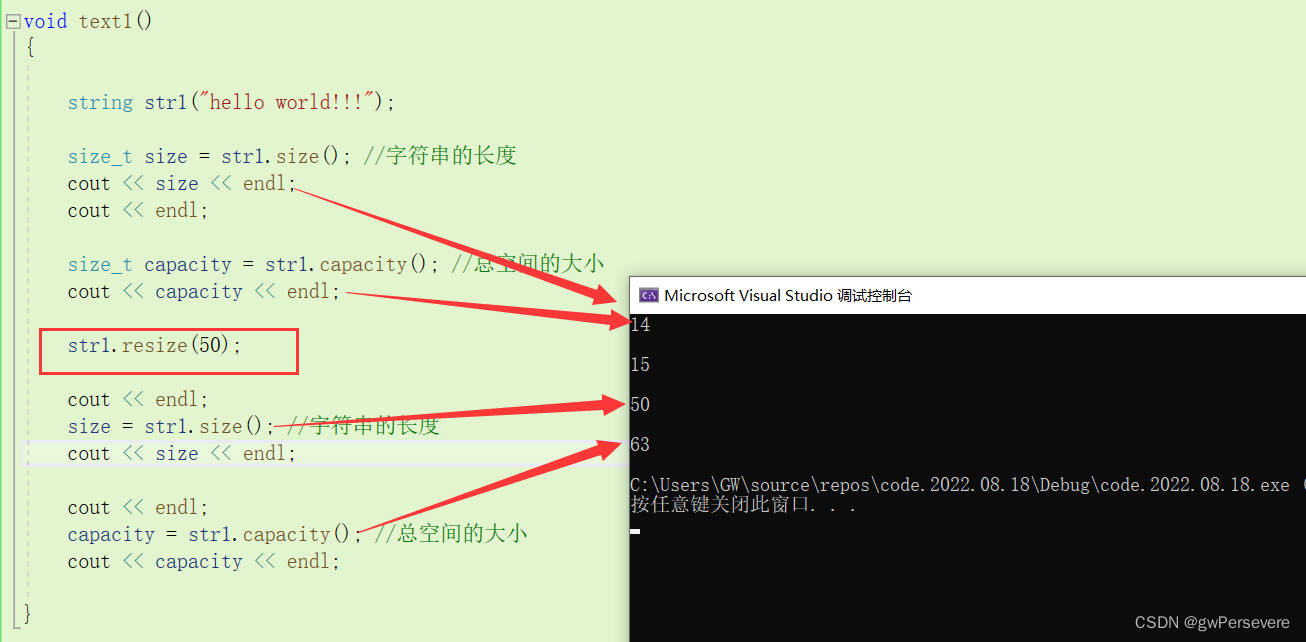
6)empty : 检测字符串是释放为空串,是返回true,不是返回 false
函数原型:bool empty() const

7)clear :清空字符串
函数原型:void clear()
将字符串清空,改变size,但是不会改变空间大小
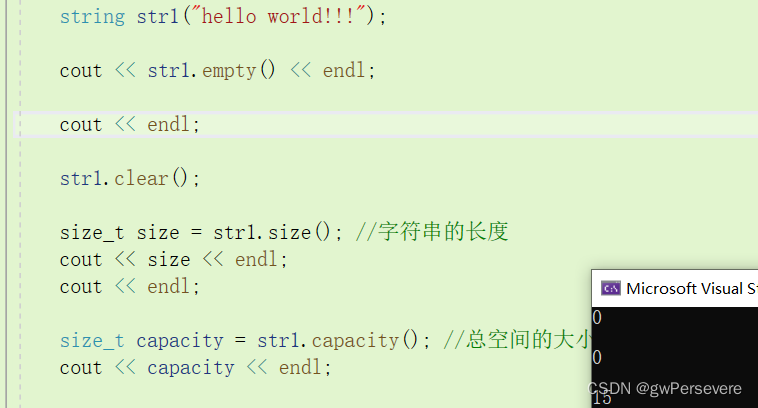
注意:
1.size()和length()方法实现底层原理完全相同,引入size()的原因是为了与其他容器的接口保持一致,一般情况下基本有size();
2.clear()只是将string中的有效字符清空,不改变底层空间大小。
3.resize ( size_t n) 与 resize (size_t n, char c)都是将字符串中的有效字符个数增加到n个,不同的是当字符串个数增多时,resize ( size_t n)用0来填充多出的空间,resize (size_t n, char c)用字符c。resize在改变元素个数时,如果将元素个数增多,可能会改变底层容量的大小,如果元素减小,底层空间不变。
4.reserve为string预留空间,不改变有效元素个数,当reserve的参数小于string的底层空间大小时,reserve不会改变容量的大小。
3.strin类对象的访问及变量操作
1)operator[] : 返回pos位置的字符
函数原型:char& operator[] (size_t pos)
const char& operator[] (size_t pos)const

因为函数是传引用返回,所以该字符可以直接被修改;即:
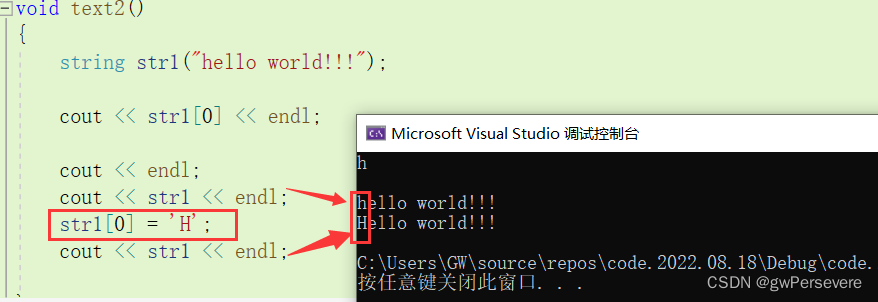
当然了如不想被更改,只能访问,那可以定义为const类型
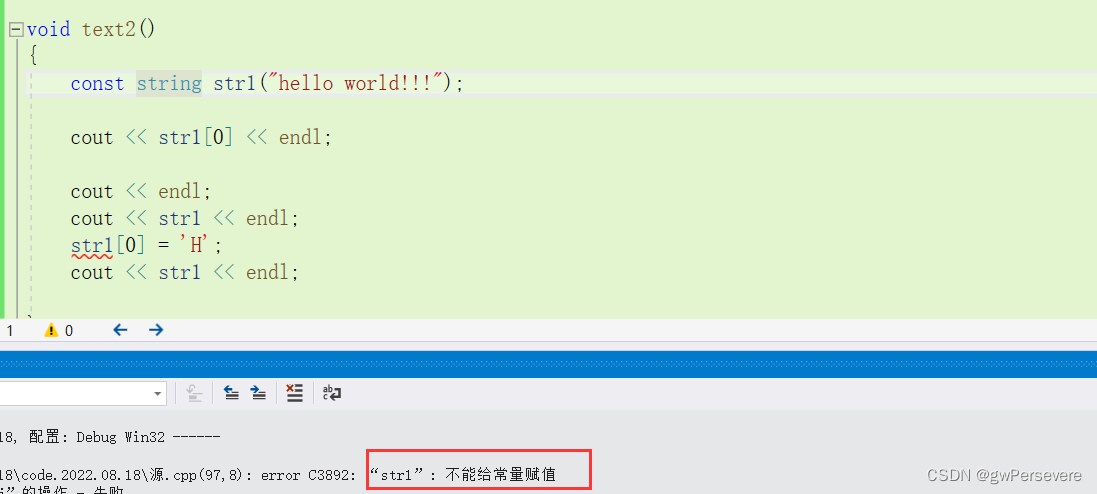
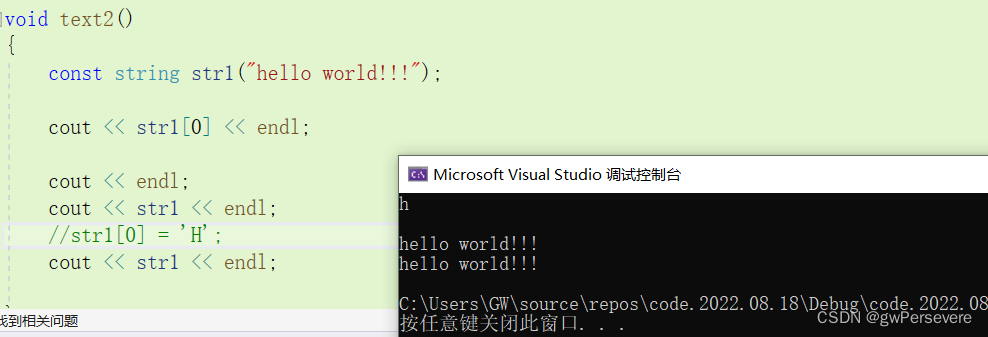
代码:
void text2()
{
const string str1("hello world!!!");
cout << str1[0] << endl;
cout << endl;
cout << str1 << endl;
//str1[0] = 'H';
cout << str1 << endl;
}2)迭代器 begin end :begin获取第一个字符迭代器,end获取最后一个字符下一个位置的迭代器。
函数原型:iterator begin();
const_iterator begin() const;
iterator end();
const_iterator end() const;
迭代器像指针,它的底层实现有可能是指针,也有可能不是指针,但是它的使用方法和指针样。
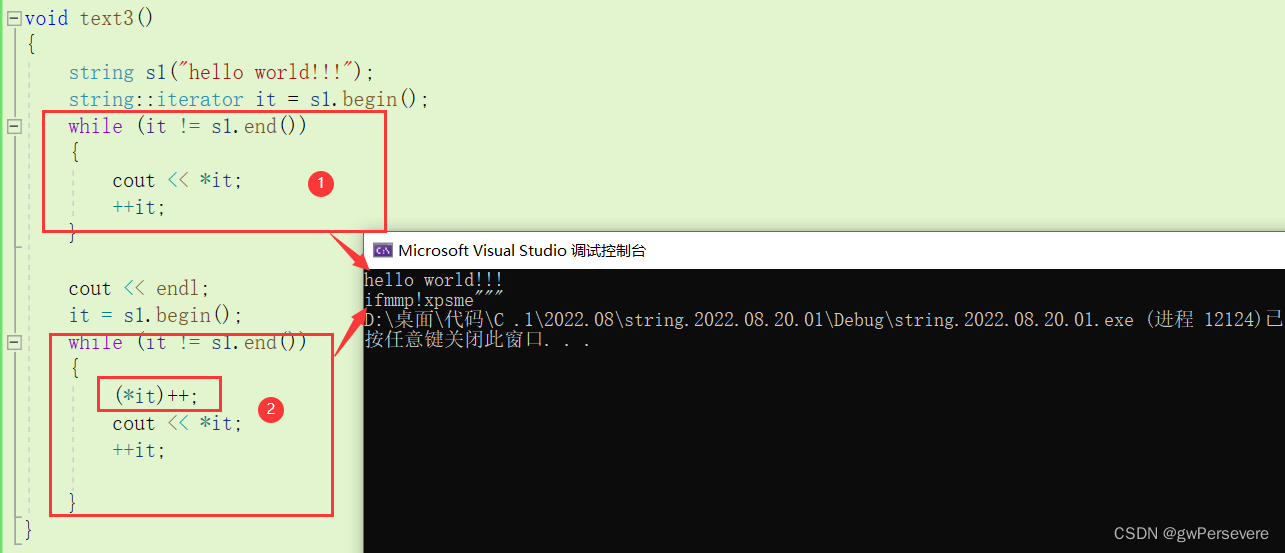
可以遍历字符串如①所示,也可更改字符串如②所示。
代码:
void text3()
{
string s1("hello world!!!");
string::iterator it = s1.begin();
while (it != s1.end())
{
cout << *it;
++it;
}
cout << endl;
it = s1.begin();
while (it != s1.end())
{
(*it)++;//更改字符
cout << *it;
++it;
}
}若使用const类型的迭代器,字符串也将不能改变。
3)反向迭代器 rbegin ,rend : rbegin获取最后一个字符位置的迭代器,rend获取第一个字符前一个位置的迭代器,与begin和end刚好相反。遍历字符串也是倒着遍历;
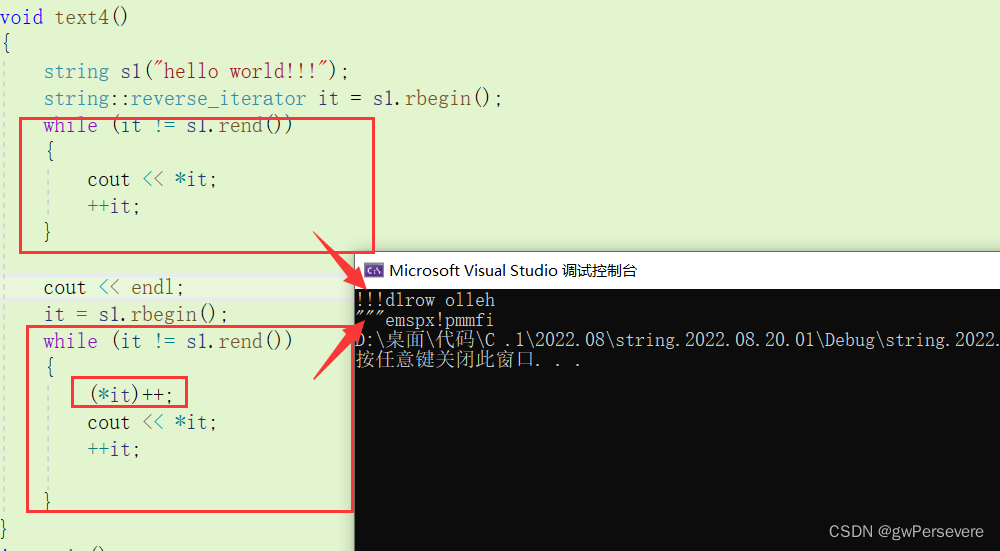
当然它也可更改字符串。
代码:
void text4()
{
string s1("hello world!!!");
string::reverse_iterator it = s1.rbegin();
while (it != s1.rend())
{
cout << *it;
++it;
}
cout << endl;
it = s1.rbegin();
while (it != s1.rend())
{
(*it)++;
cout << *it;
++it;
}
}若不想字符串被改变可用const修饰。
5)范围for
除了用迭代器遍历字符串之外,也可用范围for,范围for的底层原理便是迭代器。
范围for 自动迭代,自动判断结束
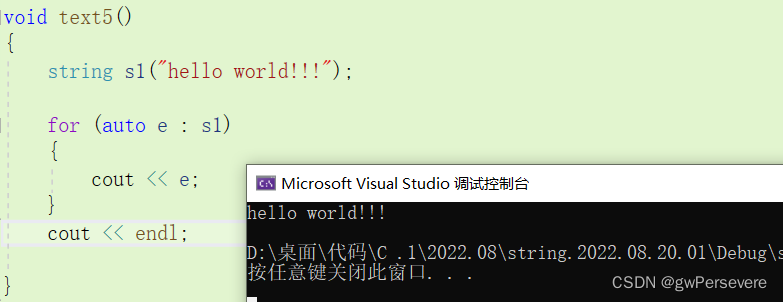
代码:
void text5()
{
string s1("hello world!!!");
for (auto e : s1)//依次取出s1中字符给e;
{
cout << e;
}
cout << endl;
}当然f范围for也可更改字符,用引用即可:
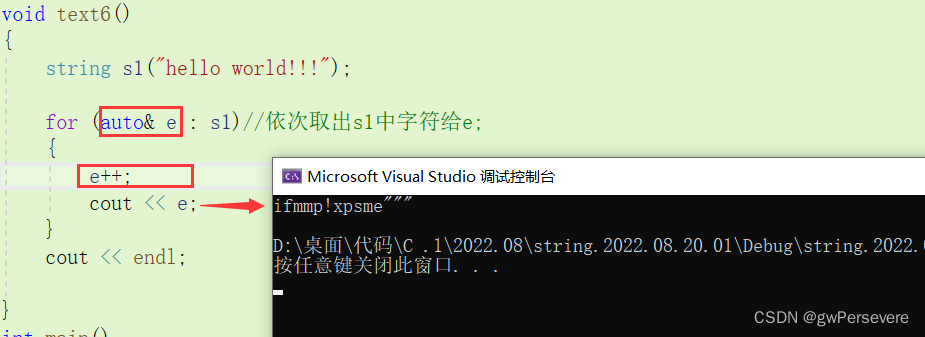
代码:
void text6()
{
string s1("hello world!!!");
for (auto& e : s1)//依次取出s1中字符给e;
{
e++;
cout << e;
}
cout << endl;
}4.string类对象的修改操作
1)push_back :在字符串后尾插字符;
函数原型: void push_back(char c)
在字符串后尾插字符c;
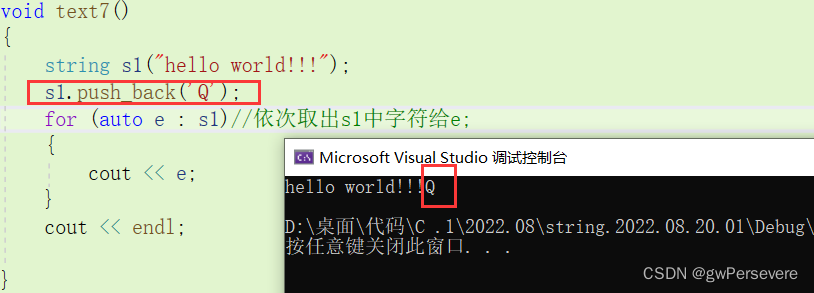
2)pop_back : 删除最后一个字符;
函数原型: void pop_back( );

3)append : 在字符串后面追加一个字符串
函数原型:string& append (const char* s) (不止这一种,其他可参考string类文档)

4)operator+= : 在字符串后加上字符或者字符串;
函数原型:string& operator+=(const string& str);
string& operator+= (const char* s);
string& operator+= (const char c);

5)c_str :返回C格式字符串(返回一个指针,这个指针指向由string类的字符所构成的数组)
函数原型: const char* c_str( ) const;

6)find:从字符串pos位置开始往后找字符/字符串,返回该字符/字符串的位置
函数原型:size_t find (const string& str, size_t pos = 0) const;
size_t find (const char* s, size_t pos = 0) const;
size_t find(char c , size_t pos = 0) const;
从pos的位置往后找,在字符串中找到与之完全相同的子串且是第一次出现,返回下标,若未找到返回 string:npos; nops 为 static const size_t npos = -1,即:size_t类型的最大值;

7)rfind: 从字符串pos位置开始往前找字符/字符串,返回该字符/字符串的位置
函数原型:size_t rfind (const string& str, size_t pos = npos) const;
size_t rfind (const char* s, size_t pos = npos) const;
size_t rfind(char c , size_t pos = pons) const;
与函数find的功能基本相同 ,区别在于rfind是用pos的位置往前找。

8)substr : 在字符串中从pos位置开始,截取n个字符,然后将其返回;
函数原型:string substr (size_t pos = 0, size_t len = npos) const;
从pos的位置截取len长度的字符串,并以string类返回;

注意:
- 在string尾部追加字符时,push_back , append , += 三种的实现方式差不多,一般情况下string类的+=操作用的较多,+=不仅能够连接字符,也可连接字符串。
- 对string操作时,如果能大概预估到放多少字符,可以先通过reserve把空间预留好
5.string类非成员函数
1)operator<<: 输出运算符重载; operator>> : 输入运算符重载
输出运算符重载是将string类类型直接输出,前面已经用过,不在赘述;
输入运算符重载:即将你在键盘上输入的字符放入string类里,但是它有个缺陷,遇到空格 或者换行符,就会结束本次输入,即当我输入 HHH空格HH是在string类里只有HHH;

空格后面的两个HH将保存在缓冲器,如果后面依然后cin<<将直接给string类不用再输入

那问题来了 我想输入带有空格的字符串怎么办? 那就要借助下面一个函数了
2)getline:
函数原型:istream& getline (istream& is, string& str);
该函数可以实现输入空格:还是我要输入HHH空格HH:

以上是string常用的接口,除此之外string类还有很多接口,感兴趣的伙伴可以去查手册。以上就是本篇博客的全部内容,若有错误,欢迎各位佬指正。感激不尽!!!!




















 2140
2140











 被折叠的 条评论
为什么被折叠?
被折叠的 条评论
为什么被折叠?








